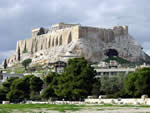

 |
The Fourth International Conference on Wireless and Mobile Communications ICWMC 2008 July 27 - August 1, 2008 - Athens, Greece |
| Tutorials |
T1. Human-Computer Interaction based on Discourse Modeling
Hermann Kaindl
T2. P2P-SIP: A Standardised P2P Approach to Multimedia Communications
Antonio Liotta and Adetola Oredope
T3. Amateur Radio Telecommunications and Networking in Education
Miroslav Skoric
DETAILS
T1. Human-Computer Interaction based on Discourse Modeling
Topics
This tutorial shows how human-computer interaction can be based on discourse modeling, even without employing speech or natural language. Communicative acts as abstractions from speech acts can model basic building blocks (“atoms”) of communication, like a question or an answer. When, e.g., a question and an answer are glued together as a so-called adjacency pair, a simple “molecule” of a dialogue is modeled. Deliberately complex discourse structures can be modeled using relations from Rhetorical Structure Theory (RST). The content of a communicative act can refer to ontologies of the domain of discourse. Taking all this together, we created a new discourse metamodel that specifies what discourse models may look like. Such discourse models can specify an interaction design. This tutorial also sketches how such an interaction design can be used for automated user-interface generation.
Proposed technical areas
The application area is clearly Human-Computer Interaction, more precisely Interaction Design for User Interfaces. Our discourse models for Interaction Design are derived from results of
Human Communication theories, Cognitive Science and Sociology. The main topic addressed by this tutorial will be the metamodel and its background, as well as its application for Interaction Design.
Prerequisite knowledge
The assumed attendee background is primarily some interest in designing interactions and user interfaces. There are no prerequisites such as knowledge about any of the results of
Human Communication theories, Cognitive Science, Sociology or HCI in general.
T2. P2P-SIP: A Standardised P2P Approach to Multimedia Communications
The Session Initiation Protocol (SIP) is an IETF standardised lightweight protocol for multimedia signalling and communication over the Internet. Due to its various advantages, SIP has been used as a platform for a wide range of services such as Voice over IP, multimedia streaming, and video on demand. However, SIP suffers from various scalability and redundancy limitations because its architecture relies on various centralised components. To overcome some of these limitations, there has been various proposed architectures for using SIP in a fully decentralised manner, with minimal or no centralised authorities. In order to provide a standardised approach to overcome these limitations in SIP, an IETF working group has been formed with the aim of working on the specifications necessary to extend SIP towards a peer-to-peer (P2P) architecture. This approach is known as P2P-SIP and it is based on the use of P2P overlays for the insertion, location, and management of SIP resources in multimedia networks. By replacing the centralised authorities in convention SIP with P2P overlays, multimedia clients can fully have end-to-end communications which in returns makes the system highly stable and redundant.
In this tutorial, we provide an overview of P2P-SIP and an in-depth description of its architecture, protocol, and application. We revisit the roadmap that led to the ongoing standardisation process and elaborate on how P2P-SIP fits in the more general telecom panorama. The tutorial is accompanied by a practical demonstration of a P2P-SIP system that will help consolidating the theoretical aspects of the protocol and appreciating its practical use. The audience is expected to be familiar with general P2P principles and motivations but does not need to have previous knowledge of SIP. This is a half-day tutorial with the following outline:
- Overview of SIP: architecture, mechanisms, and applications.
- Introduction to P2P-SIP: motivations and key features.
- P2P-SIP in operation: practical demonstration of functionality.
- P2P-SIP architecture and protocol description.
- Current standardisation developments.
- Applications and case studies.
- Outlook: prospects and open research issues.
T3. Amateur Radio Telecommunications and Networking in Education
This tutorial introduces amateur radio and its popular computer-related communication modes to both teaching and managing personnel of academic EE & CS and high-grade technical education, elementary school teachers and students of all levels of education. The purpose of tutorial is to motivate teachers to use amateur radio as an educational technology and experiment with wireless computer networks (AMUNETs - the Amateur Radio University Networks) - within their schools and university campuses; next to make connections with surrounding educational institutions, and finally to establish radio links with other parts of the globe. An AMUNET is an affordable solution for remote and rural areas, including developing countries where cell telephony infrastructures and Internet connectivity are underdeveloped. Amateur radio supports requirements of not only education institutions, but public services, scientific expeditions etc.
This tutorial is a survey of several topics: Scientific and social roles of the amateur radio in a community; Description of basic two-way computer-related radio links, as well as more complex communications over ‘digipeaters’ (digital repeaters, relay stations); Using of the amateur radio satellites; Connectivity to the TCP/IP world i.e. the Internet; Hardware choices (modems, radios, antennas, computers) and software (servers, clients, repeaters); Regulatory questions, consequences and solutions (new proposal of ADL license); Influence of the amateur radio to the national and international regulatory system; AMUNETs - the Amateur Radio University Networks, funding the further projects and development.
What will tutorial participants learn?
- Amateur radio telecommunication activities and networking systems;
- Computer in education: Simple digital communication between two and more students;
- How to solve the problem of natural or artificial obstacles between communicators;
- What communication protocols are used in amateur radio satellites;
- How to exchange e-mail without an ISP connection or even without a telephone line;
- How to build or purchase the proper computer, modem, antenna and RF subsystems;
- Network and system monitoring and management; Mobile communication relay system;
- What regulatory changes are needed to establish more amateur computer networks;
- What topics and questions belong to the new suggested ADL license’s curricula;
- Traffic modeling and monitoring the local AMUNET;